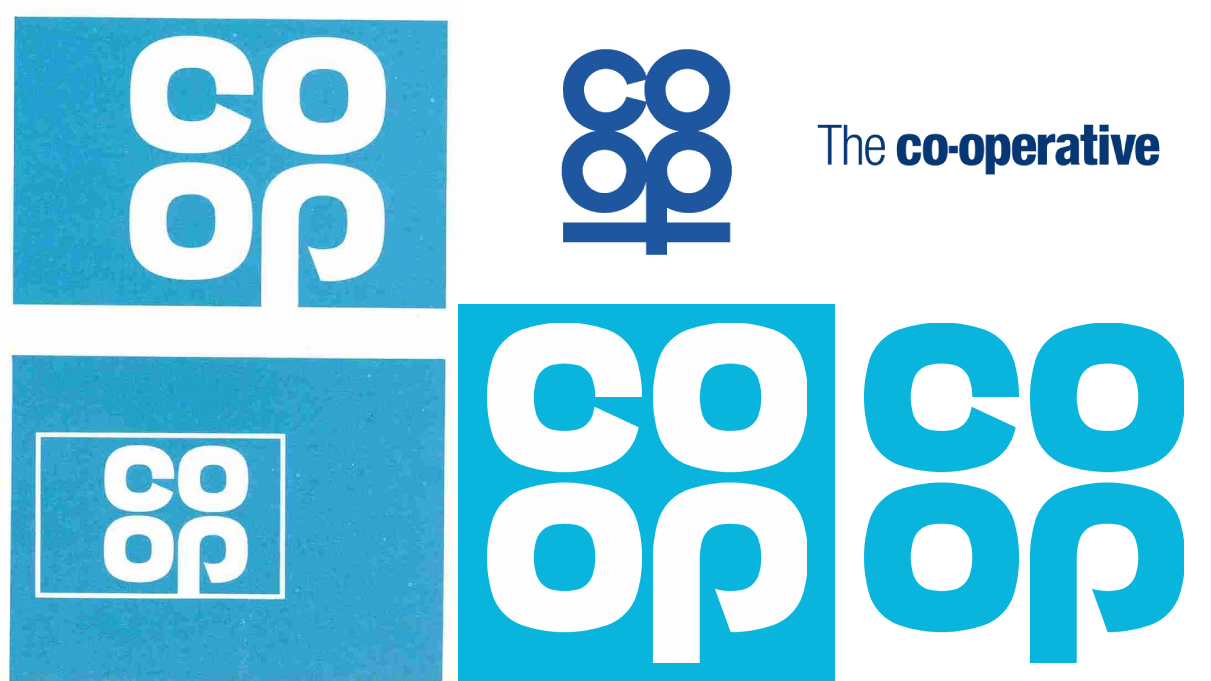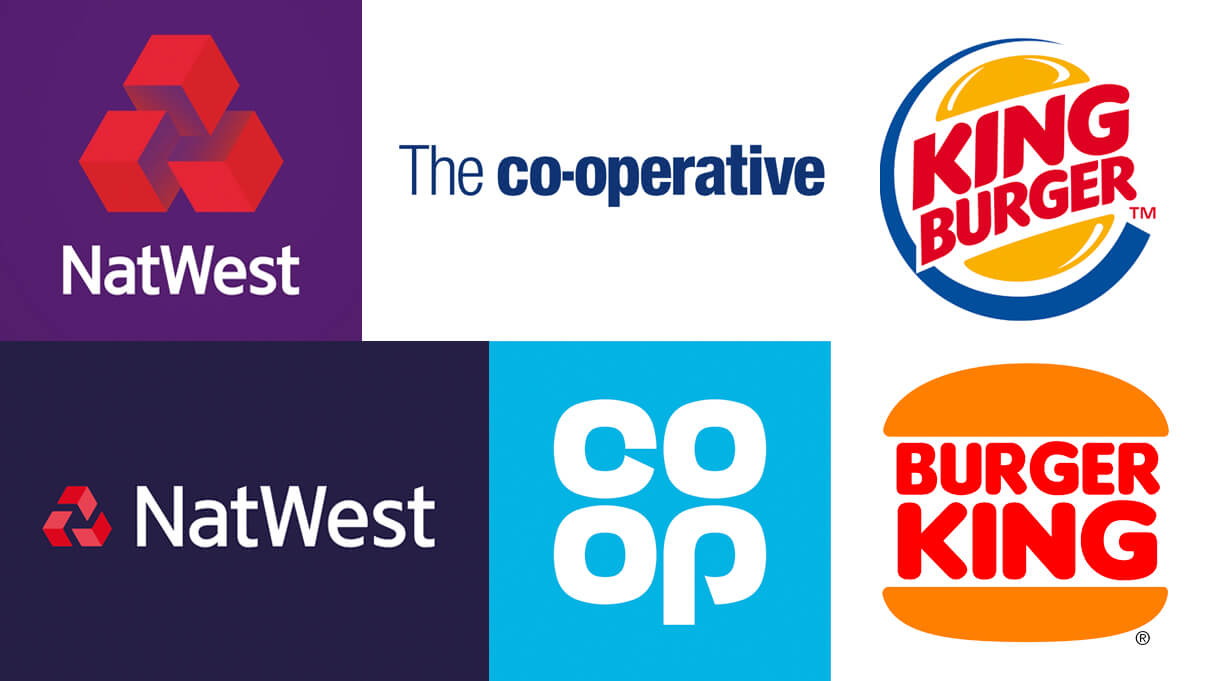In graphic design, trends come and go in the blink of an eye. What was cool yesterday is outdated today. But that doesn’t mean that an excellent design is not still an excellent design.
It’s interesting to reflect on a trend that’s been popular in branding for the past few years – that of a return to retro logo designs of the 60s and 70s.
By going back to previous designs, brands can reconnect with previous customers and establish connections with a whole new generation.
In this article, we discuss this trend, why brands are so happy to embrace the past and what it means for the future.
Several instantly recognisable brands have brought back logos from their golden eras over the past few years.
Back in 2016, the Co-op’s banking arm was at a low. It recorded a £1.5 billion black hole in its banking business and its former chair was engulfed in a public scandal. So the whole organisation had a rebrand. The Co-op dropped its corporate wordmark in favour of a modernised version of its cloverleaf logo, originally seen in 1968.

The logo was described by their chairperson, Allan Leighton as signifying “a better way of doing business.” Representing a return to traditional values, it reminded customers of the Co-op’s position as a recognisable, approachable and dynamic brand.
In the same year, another bank, Natwest used original drawings, also from 1968 to influence their new 3D logo.
In 2021, Burger King went back in time to present its new branding. This included an overhaul of its visual identity, encompassing a revamped logo, packaging and uniforms.
Thought we’d make a lil change pic.twitter.com/Tha2HbGMNp
— Burger King (@BurgerKingUK) January 13, 2021
The logo was a big departure from its previous iteration, with the simplified burger design being visually similar to the logo used throughout the 70s to the 90s.
Also in 2021, Peugeot introduced a reworking of its 1960s logo, with its iconic lion’s head displayed within a shield – the first time since the 70s they displayed the lion not standing on its hind legs.
The American Broadcasting Company has reverted to a flat logo, more similar to its 1962 iteration, removing a 3D sheen and slightly tweaking the font from the previous version.
Three years since this article was originally published, further brands have followed the retro logo trend.
In March, Pepsi rolled out its new logo in the UK. Similar to those seen throughout the 1970s to the 90s, the new visual identity features the name, Pepsi, in the white space, rather than alongside the icon as in the previous iterations. Originally rolled out in North America to celebrate the brand’s 125th anniversary, a press release announcing the rebrand states that the logo ‘thoughtfully borrows equity from its 125-year history and incorporates modern elements to create a look that is unapologetically current and undeniably Pepsi.’
By updating the colour palette, and using a modern, custom typeface, the brand has ensured that while the new look is retro in feel, it also represents a bold vision for what’s to come.
This follows Burberry updating its logo in 2023. Under the new creative direction of Daniel Lee, the company returned to its ornate Equestrian Knight Design used by the company since 1901. Alongside a serifed wordmark, the design represents a contrast to the minimal branding trend that has taken hold across the board in recent years.
The evolution of the Equestrian Knight
One of our earliest house codes, the Equestrian Knight was crowd-sourced from a public competition in around 1901. Though its design has evolved throughout the years, it remains a symbol of Burberry’s protective and progressive spirit pic.twitter.com/L4Blau4zBR
— Burberry (@Burberry) August 18, 2024
Brands change their logos for several reasons. Sometimes it’s representative of a change in direction – Peugeot is moving from petrol cars to the electric market; other times it’s reinventing themselves, as with the Co-op.
A rival making a change of their own, or just a desire to seem current, and to be constantly evolving in a changing world instigates other changes.
In recent years, brands are changing their logos in order for them to display well across digital mediums such as social media or mobile apps.
Sometimes trends simply change and your current branding becomes outdated.
Whatever the reasons for the change, it’s important not to lose sight of your brand’s purpose and history in order to not alienate your audience.

“
– Antony Sore, JDJ’s Digital Marketing Executive

As we’ve already seen, there are several reasons a brand may choose to revisit the past when redesigning its logos. These reasons are often to:
Vintage logos may also counteract modern beliefs about a company or its products and services. Burger King’s redesign, for example, reflects a feeling of tradition, quality and handmade products. These are in direct contrast to the opinions many people hold about fast-food restaurants.
With today’s consumers more demanding of their brands, trust and a compelling brand story are more important than ever. By retro-branding their organisations, brands can instantly reinforce their traditional values and reinvigorate previously held sentiments, without the need to reinvent themselves.
Because they were created in the 1960s and 70s, these logos were designed by hand, marking them distinct when compared to modern, digitally designed offerings. For example, they’re simpler than today’s designs, certainly in terms of ornate embellishments. Bevels, embosses and shadows were all made possible by computer-aided design, but – perhaps in a reflection of modern society – are now being replaced by more simple offerings.
Often based upon previous designs, these logos often do, however, incorporate modern design styles, such as bolder colours and even animated elements. While some brands may choose to return to a serif font to emphasise the retro feel, others may keep a sans serif typeface for ease of readability on digital devices.
Finally, for modern brands who lack the history to fall back on, there are still lessons to be learned. Simple is effective. Consumers more than ever are seeing through fake news in a quest for the truth. Keeping your message simple throughout your entire brand, not just your logo design, is a maxim it’s worth embracing in a post-pandemic world.
Just because some brands are going retro with their logos, doesn’t mean it’s a good thing for your organisation. Retro styling is not for everyone.
At JDJ, we create brands for organisations in a range of sectors, from financial to technology. What works for one brand would not be suitable for another. We make our suggestions and create designs based on an in-depth visual exploration of your business.
A brand is more than its visual identity. We help brands to tell their stories through colour, typography, imagery and language.
To find out how JDJ could help refresh your brand, get in contact with our design team today at hello@jdjcreative.co.uk or fill in our contact form.
Article originally published in June 2021, and updated for relevance in October 2024
Share
Sign up to our monthly newsletter to receive your guide to thought leadership design.

Sign up to our monthly newsletter to receive your guide to annual report design.

Sign up to our monthly newsletter to receive your guide to sustainability report design.
